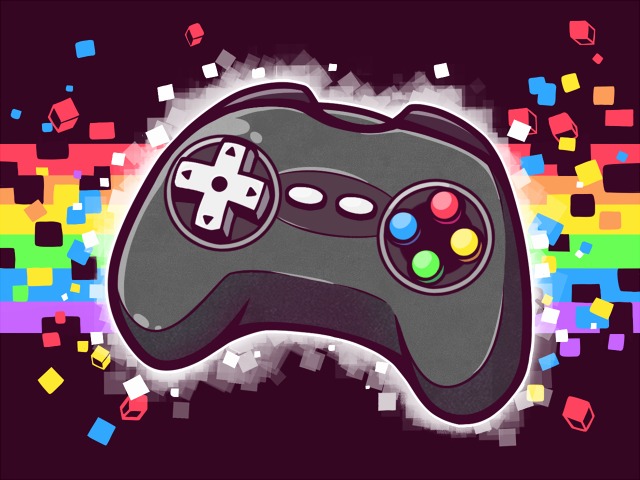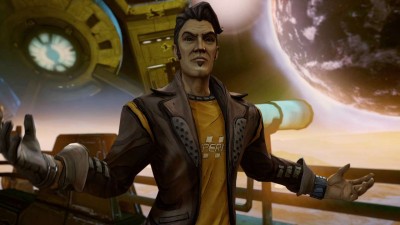DeadCore has undoubtedly flown under the radar in terms of advertising and promotion and I think it’s a damn shame – to be honest I didn’t even know it existed until I was asked to review it, and boy am I glad I was asked to review it because DeadCore is an absolute gem.
Developed by 6 friends who met while studying game design in France, who call themselves 5 Bit Games, and published by Bandai Namco, DeadCore - previously named DeadLock (in fact the website is still called DeadLock-game.com) – started life as an entry in the 7DFPS Game Jam back in 2012, an event which tasks developers with creating a first-pirst shooter in just one week. After a minor crowd funding campaign, ”real” development began in January 2013, aimed at turning their creation into a full commercial release. They soon caught the eye of publisher Bandai Namco, who promptly snapped the game up.
 Bandai Namco’s decision has proved to be good one, because DeadCore is fantastic.
Bandai Namco’s decision has proved to be good one, because DeadCore is fantastic.
What do games like Super Meat Boy, I Want To Be That Guy and DeadCore have in common? Well, for one thing they all seem to be made to be enjoyed by masochistic gamers who love to yell at their screens; but there’s a market for that.
DeadCore plays like what I would describe as a 3D platformer involving some FPS elements and it’s insanely hard. The gameplay reminds me of the type of Counter Strike: Global Offensive maps involving surfing and jump puzzling that you would find people playing late at night.
When you first spark up DeadCore you’ll be greeted with a main menu showing a great big tower in the eye of a storm, with cubes swarming around and music that would be right at home in Mass Effect or Tron. From here you have two options: Speedrun, for those of you who want to re-do older levels, beat your old time and show off your skills on the leaderboards; or Story mode.
Now, I say Story Mode, but it would be more appropriate to call it a series of levels strung together fairly loosely by various collectibles called T-Logs. There’s no over-arching narrative, no cutscenes that progress a linear plot and you won’t meet any NPCs, explore a hub level, or any of the other things that have come to define campaign modes in many contemporary games. Instead, the T-logs you pick up hold text that give you a vague idea of what’s going on and fill in a bit of the backstory about the world you occupy, why you’re there and just what this mysterious tower you’re climbing actually is. For example, an extract from one of the T-logs you pick up reads:
“The structure keeps changing and changing. Doors open, others disappear… Some of us never return. With every immersion, I pray I shall find my way back home.” – T-Log 01 – Roots
Besides that no real sense of story is handed to the player and DeadCore can just as easily be played as a storyless, more challenge oriented game. Another thing that isn’t handed to the player is any formal form of guidance in terms of how the game plays. You start out plummeting through moving structures until you eventually land on the ground and fade to black, you awaken to a bit of static that eventually dissipates and then the game begins.
Nothing pops up on the screen at this point, although you don’t have to be a complete wizz kid to be 99.9% sure that moving the mouse will probably allow you to look around, pressing space will make your character jump and that the WASD or the arrow keys will move your playable character around the game’s world. After a short moment spent finding your bearings and taking in the futuristic scenery you may spot strange words floating about in the distance.
The words: “jump”, “twice” and “higher” will slowly appear and dissapear in an orange color in a random sequence. I’m ashamed to admit that it took me a while to realize the game was hinting at the fact that I could double jump to reach higher areas. These cryptic messages appear throughout the game and slowly grow more complicated – they serve as hints to the player. (Okay, I lied – there is a tiny bit of guidance).
Those with a keen ear will notice that the sounds your character makes while moving around are distinctly robotic – this is yet another unanswered question, because the text found in the T-Logs are distinctly human and hold quite a bit of emotion. You can only speculate about your avatar’s true nature, and hope you receive your answer at some stage.
At first you’ll find the jump puzzles fairly easy; but through some well-judged pacing, DeadCore slowly introduces features in an almost undetectable way. You’ll start out simply jumping from one  platform to another in various patterns, but later on you’ll be using various rays of light which propel you high into the air, and at one point you’ll need to dodge red lasers. Before you know it, you’ll catch yourself doing things 10 times more complicated than you were a mere 5 minutes ago without even realizing (such as modifying gravity and slowing down moving objects). It was only when I stopped playing for a while and picked it up a few hours later that I realized how complicated things had actually become. 5 bit respects the intelligence of players; rather than battering you over the head with a series of mandatory tutorials or on-screen tooltips, the developer instead takes a page from the book of Valve, gradually introducing the basic concept of a mechanic and playing with it, before gradually mixing it up and and introducing other elements to contend with. Before you know it, you’ll be contending with 6 or 7 different mechanics in a single short sequence without even thinking about it, and this well-considered approach allows you to immerse yourself in the on-screen action.
platform to another in various patterns, but later on you’ll be using various rays of light which propel you high into the air, and at one point you’ll need to dodge red lasers. Before you know it, you’ll catch yourself doing things 10 times more complicated than you were a mere 5 minutes ago without even realizing (such as modifying gravity and slowing down moving objects). It was only when I stopped playing for a while and picked it up a few hours later that I realized how complicated things had actually become. 5 bit respects the intelligence of players; rather than battering you over the head with a series of mandatory tutorials or on-screen tooltips, the developer instead takes a page from the book of Valve, gradually introducing the basic concept of a mechanic and playing with it, before gradually mixing it up and and introducing other elements to contend with. Before you know it, you’ll be contending with 6 or 7 different mechanics in a single short sequence without even thinking about it, and this well-considered approach allows you to immerse yourself in the on-screen action.
Shortly into the game, you acquire something called a Switchgun. Once again, you’re given little to no instruction on how to use it and you’re left to experiment. After a while of inevitably shooting at random things something might catch your eye. A colorful symbol highlighted in the otherwise bland greyish surroundings will stand out to the player and shooting these symbols will change or ‘switch’ (hence the name) how your surroundings act and can make your surroundings easier to traverse. The Switchgun also allows you to turn various things on and off, such as turrents and those rays of light I mentioned earlier; this becomes essential later on, where forgetting to turn something off can send you flying off the tower to your doom, requiring a respawn and adding precious seconds to your par time.
With the Switchgun in hand, things only get more complicated. Within minutes you’re required to keep one eye on where you’re jumping (as your surroundings are constantly shifting), one eye on potential threats such as turrets or red laser beams and, if it were possible to have a third eye, another looking out for the highlighted symbols to shift the platforms. The result is what I call glorious frustration. Trust me, you’ll fail over and over again and you’ll definitely get frustrated but each time you restart a section you’ll learn from previous mistakes and find yourself progressing further and further until you eventually finish it. The thrill of finally finishing a tough level is equivalent to that of triumphing over a particularly hard boss in a Souls game. Soon enough you’ll see climbing further up this cubic mechanical monstrosity (that seems like a living breathing thing the way it moves around) as an addiction.
 In terms of visuals, DeadCore channels Tron and Portal: the base color scheme is dark, spaced out and sterile, but there are highlighted elements that bring the edge off of what would otherwise be an extremely boring visual experience. Something else that DeadCore gets right is the draw distance on the tower you’re climbing - it’s an amazing feeling to be able to turn around at any point and look down at the levels you’ve already conquered, before looking up at the trials and obstacles that await you. The effect is both a sense of pride and anxiety.
In terms of visuals, DeadCore channels Tron and Portal: the base color scheme is dark, spaced out and sterile, but there are highlighted elements that bring the edge off of what would otherwise be an extremely boring visual experience. Something else that DeadCore gets right is the draw distance on the tower you’re climbing - it’s an amazing feeling to be able to turn around at any point and look down at the levels you’ve already conquered, before looking up at the trials and obstacles that await you. The effect is both a sense of pride and anxiety.
All in all, DeadCore is an wonderfully pure videogame that rewards patience and perseverance. 5 bit Games has managed to provide a great challenge to those who attempt to climb its mysterious tower. the 8 or so hours it takes to finish will provide you with a near flawless experience, while those seeking to perfect their runs through the various gauntlets could easily sink dozens, if not hundreds of hours into climbing the leaderboards and finding shortcuts that shave precious milliseconds from their times. I would go as far to as to say that Portal could have a potential rival on its hands – the puzzles are just as challenging (in their own way), the level design is unique and the shroud of mystery that surrounds the mechanical tower provides a grand sense of awe. Steam Workshop support is sadly missing in the initial release; the ability to construct levels from the various building blocks which make up each section would work wonders for extending the game’s lifespan and building up a dedicated community, so if 5 bit Games want an idea about how to build on the already-great experience they’ve crafted, this is something for them to look at.
DeadCore may well have come out of nowhere, with minimal hype and little marketing despite having been picked up by a major publisher; but don’t let that fool you. For a game resulting from a jam and crafted by a small team of passionate designers, DeadCore is up there as one of the most impressive PC releases of the year so far. Whether you’re a fan of platformers, puzzlers, or perfecting speedruns, you owe it to yourself to at least give it a look. You won’t regret it.









